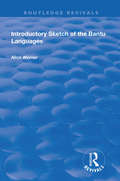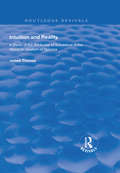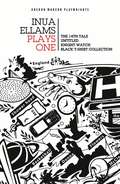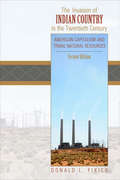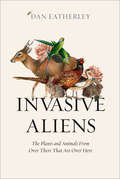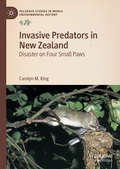- Table View
- List View
An Introductory Guide to Qualitative Research in Art Museums (Routledge Guides to Practice in Museums, Galleries and Heritage)
by Ann Rowson Love Deborah RandolphAn Introductory Guide to Qualitative Research in Art Museums is a practice-based guide that is designed to introduce qualitative research to established and upcoming museum professionals and increase their confidence to conduct this type of research. Highlighting the work of researchers who are studying museums around the world, the book begins by explaining why there is a need for qualitative research in museums. Rowson Love and Randolph then go on to provide guidance, including theories and frameworks, on how to envision a qualitative research project that facilitates meaningful interpretation of visitor experiences. Chapters in the methodology section begin with descriptions of featured qualitative methodologies and will assist readers as they determine which are most appropriate for their projects and as they advocate for their research. The final section will prepare readers still further by demonstrating data analysis and reporting using the examples in the book. An Introductory Guide to Qualitative Research in Art Museums will help museum professionals and students engaged in the study of museums expand their repertoire to include qualitative methodologies and explain the methods needed to conduct, analyze, and report their qualitative research. It will be particularly useful to those with an interest in museum education, visitor studies and audience research, exhibition development, leadership, and management.
An Introductory Guide to Qualitative Research in Art Museums (Routledge Guides to Practice in Museums, Galleries and Heritage)
by Ann Rowson Love Deborah RandolphAn Introductory Guide to Qualitative Research in Art Museums is a practice-based guide that is designed to introduce qualitative research to established and upcoming museum professionals and increase their confidence to conduct this type of research. Highlighting the work of researchers who are studying museums around the world, the book begins by explaining why there is a need for qualitative research in museums. Rowson Love and Randolph then go on to provide guidance, including theories and frameworks, on how to envision a qualitative research project that facilitates meaningful interpretation of visitor experiences. Chapters in the methodology section begin with descriptions of featured qualitative methodologies and will assist readers as they determine which are most appropriate for their projects and as they advocate for their research. The final section will prepare readers still further by demonstrating data analysis and reporting using the examples in the book. An Introductory Guide to Qualitative Research in Art Museums will help museum professionals and students engaged in the study of museums expand their repertoire to include qualitative methodologies and explain the methods needed to conduct, analyze, and report their qualitative research. It will be particularly useful to those with an interest in museum education, visitor studies and audience research, exhibition development, leadership, and management.
An Introductory History of British Broadcasting
by Andrew CrisellAn Introductory History of British Broadcasting is a concise and accessible history of British radio and television. It begins with the birth of radio at the beginning of the twentieth century and discusses key moments in media history, from the first wireless broadcast in 1920 through to recent developments in digital broadcasting and the internet.Distinguishing broadcasting from other kinds of mass media, and evaluating the way in which audiences have experienced the medium, Andrew Crisell considers the nature and evolution of broadcasting, the growth of broadcasting institutions and the relation of broadcasting to a wider political and social context. This fully updated and expanded second edition includes:*the latest developments in digital broadcasting and the internet*broadcasting in a multimedia era and its prospects for the future*the concept of public service broadcasting and its changing role in an era of interactivity, multiple channels and pay per view*an evaluation of recent political pressures on the BBC and ITV duopoly*a timeline of key broadcasting events and annotated advice on further reading.
An Introductory History of British Broadcasting
by Andrew CrisellAn Introductory History of British Broadcasting is a concise and accessible history of British radio and television. It begins with the birth of radio at the beginning of the twentieth century and discusses key moments in media history, from the first wireless broadcast in 1920 through to recent developments in digital broadcasting and the internet.Distinguishing broadcasting from other kinds of mass media, and evaluating the way in which audiences have experienced the medium, Andrew Crisell considers the nature and evolution of broadcasting, the growth of broadcasting institutions and the relation of broadcasting to a wider political and social context. This fully updated and expanded second edition includes:*the latest developments in digital broadcasting and the internet*broadcasting in a multimedia era and its prospects for the future*the concept of public service broadcasting and its changing role in an era of interactivity, multiple channels and pay per view*an evaluation of recent political pressures on the BBC and ITV duopoly*a timeline of key broadcasting events and annotated advice on further reading.
Introductory Readings in Anthropology
by Hilary Callan Brian Street Simon UnderdownAnthropology seeks to understand the roots of our common humanity, the diversity of cultures and world-views, and the organisation of social relations and practices. As a method of inquiry it embraces an enormous range of topics, and as a discipline it covers a multitude of fields and themes, as shown in this selection of original writings. As an accessible entry point, for upper-level students and first year undergraduates new to the study of anthropology, this reader also offers guidance for teachers in exploring the subject’s riches with their students. That anthropology is an immensely expansive inquiry of study is demonstrated by the diversity of its topics – from nature conservation campaigns to witchcraft beliefs, from human evolution to fashion and style, and from the repatriation of indigenous human remains to research on literacy. There is no single ‘story of anthropology’. Taken together, these fundamental readings are evidence of a contemporary, vibrant subject that has much to tell us about all the worlds in which we live.
Introductory Remote Sensing Principles and Concepts
by Paul Gibson With contributions from Clare PowerIntroduction to Remote Sensing Principles and Concepts provides a comprehensive student introduction to both the theory and application of remote sensing. This textbook* introduces the field of remote sensing and traces its historical development and evolution* presents detailed explanations of core remote sensing principles and concepts providing the theory required for a clear understanding of remotely sensed images.* describes important remote sensing platforms - including Landsat, SPOT and NOAA * examines and illustrates many of the applications of remotely sensed images in various fields.A unique World Wide Web site accompanies this textbook. Developed for the users of Netscape 3 / Internet Explorer or above, this site offers:* over 45 full colour images with descriptions* examples illustrating remote sensing applications for meteorology, geology, vegetation studies, urban studies and oceanography * material from the Americas, the UK, Ireland, Africa, Australasia, Africa and Western Europe* Image exercises, with answers* Shorter questions and answers on remote sensing* An online glossary of terms, links to sources of useful remote sensing information available online.
Introductory Remote Sensing Principles and Concepts
by Paul Gibson With contributions from Clare PowerIntroduction to Remote Sensing Principles and Concepts provides a comprehensive student introduction to both the theory and application of remote sensing. This textbook* introduces the field of remote sensing and traces its historical development and evolution* presents detailed explanations of core remote sensing principles and concepts providing the theory required for a clear understanding of remotely sensed images.* describes important remote sensing platforms - including Landsat, SPOT and NOAA * examines and illustrates many of the applications of remotely sensed images in various fields.A unique World Wide Web site accompanies this textbook. Developed for the users of Netscape 3 / Internet Explorer or above, this site offers:* over 45 full colour images with descriptions* examples illustrating remote sensing applications for meteorology, geology, vegetation studies, urban studies and oceanography * material from the Americas, the UK, Ireland, Africa, Australasia, Africa and Western Europe* Image exercises, with answers* Shorter questions and answers on remote sensing* An online glossary of terms, links to sources of useful remote sensing information available online.
Introductory Sketch of the Bantu Languages (Routledge Revivals)
by Alice WernerFirst published in 1919, this volume provides a detailed linguistic breakdown of the Bantu language family of Central and Southern Africa. Its author held in-situ expertise in Nanja, Swahili, Zulu, Giryama and Pokomo. A professor of Swahili and Bantu languages, she was the author of several books on Bantu languages and African peoples. The volume aims to depict the broad principles underlying the structure of the Bantu language family and attempts a classification of those languages. Contemporaneous with the colonization of Tanzania, many of the areas to which this volume was relevant were under British control at the time of publication.
Introductory Sketch of the Bantu Languages (Routledge Revivals)
by Alice WernerFirst published in 1919, this volume provides a detailed linguistic breakdown of the Bantu language family of Central and Southern Africa. Its author held in-situ expertise in Nanja, Swahili, Zulu, Giryama and Pokomo. A professor of Swahili and Bantu languages, she was the author of several books on Bantu languages and African peoples. The volume aims to depict the broad principles underlying the structure of the Bantu language family and attempts a classification of those languages. Contemporaneous with the colonization of Tanzania, many of the areas to which this volume was relevant were under British control at the time of publication.
Introductory Spatial Analysis (Routledge Revivals)
by David UnwinFirst published in 1981, Introductory Spatial Analysis uses ideas from dimensional analysis and stochastic process theory to provide a consistent, logical framework for map analysis. ‘Geography is about maps’, so the saying goes, yet there is no other textbook for geography students that combines the discussion of maps with a treatment of quantitative methods of map analysis. This book differs from most other quantitative or cartographic geography texts in three respects: first it is a geography, not a statistics book, and therefore problems are examined by looking at the types of data used and the varieties of maps drawn and then at the analytical procedures that may be used to detect significant spatial patterns; second, no attempt is made to introduce tests that treat data without reference to their spatial location; and third, no advice is offered on specifically cartographic questions of map drawing and design.David Unwin’s text will serve as a valuable introduction to the techniques of spatial analysis that are so important in contemporary geographical study.
Introductory Spatial Analysis (Routledge Revivals)
by David UnwinFirst published in 1981, Introductory Spatial Analysis uses ideas from dimensional analysis and stochastic process theory to provide a consistent, logical framework for map analysis. ‘Geography is about maps’, so the saying goes, yet there is no other textbook for geography students that combines the discussion of maps with a treatment of quantitative methods of map analysis. This book differs from most other quantitative or cartographic geography texts in three respects: first it is a geography, not a statistics book, and therefore problems are examined by looking at the types of data used and the varieties of maps drawn and then at the analytical procedures that may be used to detect significant spatial patterns; second, no attempt is made to introduce tests that treat data without reference to their spatial location; and third, no advice is offered on specifically cartographic questions of map drawing and design.David Unwin’s text will serve as a valuable introduction to the techniques of spatial analysis that are so important in contemporary geographical study.
The Introspective Realist Crime Film
by Luis M. García-MainarThis book explores the formal and thematic conventions of crime film, the contexts in which these have flourished and their links with the social issues of a globalized world. The crime film has traditionally been identified with suspense, a heterogeneous aesthetic and a tacit social mind. However, a good number of the crime films produced since the early 2000s have shifted their focus from action or suspense and towards melodrama in narratives that highlight the social dimension of crime, intensify their realist aesthetics and dwell on subjectivity. With the 1940s wave of Hollywood semi-documentary crime films and 1970s generic revisionism as antecedents, these crime films find inspiration in Hollywood cinema and constitute a transnational trend. With a close look at Steven Soderbergh’s Traffic (2000), David Fincher’s Zodiac (2007), Jacques Audiard’s Un prophète (2009) and Tomas Alfredson’s Tinker Tailor Soldier Spy (2011), this book sets out the stylistic and thematic conventions, contexts and cultural significance of a new transnational trend in crime film.
Intruder Alarms
by Gerard HoneyIntruder Alarms provides a definitive and fully up-to-date guide to the specification, systems design, integration, installation and maintenance of intruder alarm systems. It has been written to be the essential handbook for installation engineers and security professionals working in this rapidly expanding and developing area. The third edition includes new material on systems integration, digital systems, wireless and remote signalling technologies, and electrical safety.The revision has brought coverage fully in line with the new European standards (EN50131 / BS EN 50131-1), with their implications summarised in a new appendix. The coverage has also been carefully matched to the requirements of the new Knowledge of Security and Emergency Alarm Systems from City & Guilds (1852).* An hugely popular practical guide for installation engineers and security professionals now in its third edition* Essential reading for managers responsible for the commissioning and maintenance of security alarm systems * Third edition is fully matched to the new European standards (EN50131 / BS EN 50131-1)* Coverage meets City & Guilds specifications for the new 1852 Security Alarm course
Intuition and Reality: A Study of the Attributes of Substance in the Absolute Idealism of Spinoza (Routledge Revivals)
by James ThomasPublished in 1999, this study focuses on the work of absolute idealist readers of Spinoza's metaphysics, such as John Clark Murray and Leslie Armour. The text is intended to establish a better absolute idealist interpretation of the identity of Spinoza's one substance (reality) with each of its diversity of "attributes". Consideration is given to the interpretations developed by these earlier commentators, who read the attributes as one metaphysical being diversely interpreted. The author finds this disadvantageous in understanding the "parallelism" of the attributes, or Spinoza's doctrine that the same order and connection of things is found in each. This problem can be solved with an alternative absolute idealist reading of the attributes as one order diversely intuited.
Intuition and Reality: A Study of the Attributes of Substance in the Absolute Idealism of Spinoza (Routledge Revivals)
by James ThomasPublished in 1999, this study focuses on the work of absolute idealist readers of Spinoza's metaphysics, such as John Clark Murray and Leslie Armour. The text is intended to establish a better absolute idealist interpretation of the identity of Spinoza's one substance (reality) with each of its diversity of "attributes". Consideration is given to the interpretations developed by these earlier commentators, who read the attributes as one metaphysical being diversely interpreted. The author finds this disadvantageous in understanding the "parallelism" of the attributes, or Spinoza's doctrine that the same order and connection of things is found in each. This problem can be solved with an alternative absolute idealist reading of the attributes as one order diversely intuited.
Intuitive Predictions and Professional Forecasts: Cognitive Processes and Social Consequences (International Series in Experimental Social Psychology #Volume 20)
by Jurgen T. Rehm Volker GadenneThis volume discusses new approaches for the integration of cognitive psychology and professional forecasting, conceptual clarification of intuition and its role in predictions and forecasts. The authors present empirical tests of the theoretical assumptions in the area of psychiatric prognosis, election predictions and energy consumption forecasts. The book goes beyond the individual perspective and deals with technological problems and the social consequences of predictions. The reader is given a vivid overview for judgemental forecasting with special emphasis on practical problems.
Inua Ellams: The 14th Tale; Untitled; Knight Watch; Black T-Shirt Collection (Oberon Modern Playwrights)
by Inua EllamsInua Ellams has established himself as one of the most distinctive voices in British and international theatre. Collected together for the first time are four of Ellams’ acclaimed plays, including The 14th Tale, Untitled, Black T-Shirt Collection and Knight Watch. ‘A sharp reminder of the power of language and rhythm’ The Scotsman on The 14th Tale ‘Ellams’s evocative writing conjures a Nigeria where myth and magic sit casually alongside everyday life.’ The Guardian on Untitled ‘Ellams’ verse brims with magical realism... His delivery is charming and natural, and he is able to spin intricate, rhythmic webs of words with apparent ease. 45 minutes of allowing Inua Ellams to wrap his words around you is far from a painful experience. What is clear is that Ellams’ writing and performance, not to mention his Fringe First award, show that he has definite potential.’ What’s On Stage on Knight Watch ‘Full of arresting images that create a hybrid of lyrical ecstasy and cinematic effects… a fluent, intense 70-minute confection and a tinglingly resonant celebration of the art of solo performance.’ Evening Standard on Black T-Shirt Collection
The Inuit World (Routledge Worlds)
by Pamela SternThe Inuit World is a robust and holistic reference source to contemporary Inuit life from the intimate world of the household to the global stage. Organized around the themes of physical worlds, moral, spiritual and intellectual worlds, intimate and everyday worlds, and social and political worlds, this book includes ethnographically rich contributions from a range of scholars, including Inuit and other Indigenous authors. The book considers regional, social, and cultural differences as well as the shared histories and common cultural practices that allow us to recognize Inuit as a single, distinct Indigenous people. The chapters demonstrate both the historical continuity of Inuit culture and the dynamic ways that Inuit people have responded to changing social, environmental, political, and economic conditions. Chapter topics include ancestral landscapes, tourism and archaeology, resource extraction and climate change, environmental activism, and women’s leadership. This book is an invaluable resource for students and researchers in anthropology, Indigenous studies, and Arctic studies and those in related fields including geography, history, sociology, political science, and education.
The Inuit World (Routledge Worlds)
by Pamela SternThe Inuit World is a robust and holistic reference source to contemporary Inuit life from the intimate world of the household to the global stage. Organized around the themes of physical worlds, moral, spiritual and intellectual worlds, intimate and everyday worlds, and social and political worlds, this book includes ethnographically rich contributions from a range of scholars, including Inuit and other Indigenous authors. The book considers regional, social, and cultural differences as well as the shared histories and common cultural practices that allow us to recognize Inuit as a single, distinct Indigenous people. The chapters demonstrate both the historical continuity of Inuit culture and the dynamic ways that Inuit people have responded to changing social, environmental, political, and economic conditions. Chapter topics include ancestral landscapes, tourism and archaeology, resource extraction and climate change, environmental activism, and women’s leadership. This book is an invaluable resource for students and researchers in anthropology, Indigenous studies, and Arctic studies and those in related fields including geography, history, sociology, political science, and education.
The Invaders: How Humans And Their Dogs Drove Neanderthals To Extinction
by Pat ShipmanHumans domesticated dogs soon after Neanderthals began to disappear. This alliance between two predator species, Pat Shipman hypothesizes, made possible unprecedented success in hunting large Ice Age mammals—a distinct and ultimately decisive advantage for human invaders at a time when climate change made both humans and Neanderthals vulnerable.
The Invaders: How Humans And Their Dogs Drove Neanderthals To Extinction
by Pat ShipmanHumans domesticated dogs soon after Neanderthals began to disappear. This alliance between two predator species, Pat Shipman hypothesizes, made possible unprecedented success in hunting large Ice Age mammals—a distinct and ultimately decisive advantage for human invaders at a time when climate change made both humans and Neanderthals vulnerable.
The Invasion of Indian Country in the Twentieth Century: American Capitalism and Tribal Natural Resources, Second Edition
by Donald Fixico Donald Lee FixicoThe Invasion of Indian Country in the Twentieth Century, Second Edition is updated through the first decade of the twenty-first century and contains a new chapter challenging Americans--Indian and non-Indian--to begin healing the earth. This analysis of the struggle to protect not only natural resources but also a way of life serves as an indispensable tool for students or anyone interested in Native American history and current government policy with regard to Indian lands or the environment.
Invasive Aliens: The Plants And Animals From Over There That Are Over Here
by Dan EatherleyA Sunday Times Book of the Year A Telegraph Best Science Book of the Year A Waterstones Best Nature Book of the Year A unique history of plant and animal invaders of the British isles spanning thousands of years of arrivals and escapes, as well as defences mounted and a look to the future.
Invasive Predators in New Zealand: Disaster on Four Small Paws (Palgrave Studies in World Environmental History)
by Carolyn M. KingThe story of invasive species in New Zealand is unlike any other in the world. By the mid-thirteenth century, the main islands of the country were the last large landmasses on Earth to remain uninhabited by humans, or any other land mammals. New Zealand’s endemic fauna evolved in isolation until first Polynesians, and then Europeans, arrived with a host of companion animals such as rats and cats in tow. Well-equipped with teeth and claws, these small furry mammals, along with the later arrival of stoats and ferrets, have devastated the fragile populations of unique birds, lizards and insects. Carolyn M. King brings together the necessary historical analysis and recent ecological research to understand this long, slow tragedy. As a comprehensive historical perspective on the fate of an iconic endemic fauna, this book offers much-needed insight into one of New Zealand’s longest-running national crises.
Invective Gaze - Das digitale Bild und die Kultur der Beschämung (Edition Medienwissenschaft #99)
by Elisabeth Heyne Tanja ProkicDer schaulüsterne Blick: Bilder adressieren affektive Register, fördern somit voyeuristische Tendenzen wie Glotzen, Gaffen und den Drang, sich oder andere im Bild zu exponieren. Digitale Medien ermöglichen direkte Beteiligung und Bewertung, wodurch sich das intrikate Verhältnis zwischen Bildern und gesellschaftlichen Anerkennungsprozessen nachhaltig verschiebt. Dabei hat ein abwertender, entblößender Blick Konjunktur, der neue Bildgenres hervorbringt und das Affektive, Politische und Ökonomische neu verknüpft. Die Beiträger:innen folgen der Karriere des invective gaze vom Analogen zum Digitalen, von Figuren des Gaffers im 19. Jahrhundert bis zum Terror im Livestream.





